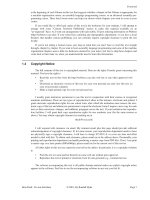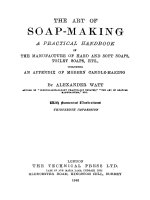The art of assembly language 2003
Bạn đang xem bản rút gọn của tài liệu. Xem và tải ngay bản đầy đủ của tài liệu tại đây (5.66 MB, 1,406 trang )
TheArtofAssembly
Language
ISBN:1886411972
byRandall
Hyde
NoStarchPress©2003(903
pages)
Presentingassembly
languagefromthehigh-level
programmer'spointofview,
thisguideexplainshowto
edit,compile,andrunan
HLAprogram,converthigh
levelcontrolstructures,
translatearithmetic
expressions,andmore.
CDContent
TableofContents
TheArtofAssemblyLanguage
Hello,WorldofAssembly
Chapter1 Language
Chapter2 - DataRepresentation
MemoryAccessand
Chapter3 Organization
Constants,Variables,and
Chapter4 DataTypes
Chapter5 - ProceduresandUnits
Chapter6 - Arithmetic
LowLevelControl
Chapter7 Structures
Chapter8 - Files
Chapter9 - AdvancedArithmetic
MacrosandtheHLA
Chapter10 CompileTimeLanguage
Chapter11 - BITManipulation
Chapter12 - TheStringInstructions
Chapter13 - TheMMXInstructionSet
Chapter14 - ClassesandObjects
MixedLanguage
Chapter15 Programming
AppendixA - ASCIICharacterSet
The80×86Instruction
AppendixB Set
Index
ListofFigures
ListofTables
ListofListings
CDContent
BackCover
Assemblylanguageiseasierthanever,thanksto
moderndevelopmenttoolsandTheArtofAssembly
Language.
Afteradecadeofrigorousend-usertestingofthe
onlineversion,TheArtofAssemblyLanguageisan
indispensablereferenceforusingassemblytowrite
powerfulprogramsandsolvereal-worldproblems.
Hydehasupdatedhisbooktoincludethelatestin32bitx86architecture,aswellastheHighLevel
Assembler(HLA),arevolutionarytoolthatleverages
yourknowledgeofhighlevelprogramminglanguages
likeC/C++andPascal/Delphitostreamlineyour
learningprocess.
Learnhowto:
Edit,compile,andrunaHighLevelAssembler
(HLA)program
Declareanduseconstants,scalarvariables,
integers,reals,datatypes,pointers,arrays,
records/structures,unions,andnamespaces
Translatearithmeticexpressions(integerand
floatingpoint)
Converthighlevelcontrolstructures
Interfacewithhighlevelprogramminglanguages
AbouttheAuthor
RandallHydehastaughtassemblylanguageatthe
universitylevelforoveradecade,andhasdeveloped
severalcommercialsoftwaresystems.Hiswebsite,
“Webster:ThePlaceontheNettoLearnAssembly
LanguageProgramming,”isthepremierdestinationfor
anyonelearningassembly.HydeistheauthorofHow
toProgramtheAppleIIUsing6502Assembly
Languageandco-authorofTheWaiteGroup’sMASM
6.0Bible.
TheArtofAssemblyLanguage
RandallHyde
NOSTARCHPRESS
SanFrancisco
Copyright©2003RandallHyde.
Allrightsreserved.Nopartofthisworkmaybereproducedortransmitted
inanyformorbyanymeans,electronicormechanical,including
photocopying,recording,orbyanyinformationstorageorretrieval
system,withoutthepriorwrittenpermissionofthecopyrightownerand
thepublisher.
12345678910–06050403
NoStarchPressandtheNoStarchPresslogoareregisteredtrademarks
ofNoStarchPress,Inc.Otherproductandcompanynamesmentioned
hereinmaybethetrademarksoftheirrespectiveowners.Ratherthan
useatrademarksymbolwitheveryoccurrenceofatrademarkedname,
weareusingthenamesonlyinaneditorialfashionandtothebenefitof
thetrademarkowner,withnointentionofinfringementofthetrademark.
Publisher:WilliamPollock
ManagingEditor:KarolJurado
CoverandInteriorDesign:OctopodStudios
Copyeditor:KenyonBrown
Proofreader:StephanieProvines
Compositor:Wedobooks
DistributedtothebooktradeintheUnitedStatesbyPublishersGroup
West,1700FourthStreet,Berkeley,CA94710;phone:800-788-3123;
fax:510-658-1834.
DistributedtothebooktradeinCanadabyJacquelineGross&
Associates,Inc.,OneAtlanticAvenue,Suite105,Toronto,OntarioM6K
3E7Canada;phone:416-531-6737;fax416-531-4259.
ForinformationontranslationsorbookdistributorsoutsidetheUnited
States,pleasecontactNoStarchPress,Inc.directly:
NoStarchPress,Inc.
555DeHaroStreet,Suite250,SanFrancisco,CA94107
phone:415-863-9900;fax:415-863-9950;;
Theinformationinthisbookisdistributedonan"AsIs"basis,without
warranty.Whileeveryprecautionhasbeentakeninthepreparationof
thiswork,neithertheauthornorNoStarchPress,Inc.shallhaveany
liabilitytoanypersonorentitywithrespecttoanylossordamagecaused
orallegedtobecauseddirectlyorindirectlybytheinformationcontained
init.
LibraryofCongressCataloguing-in-PublicationData
Hyde,Randall.
Theartofassemblylanguage/RandallHyde.
p.cm.
1-886411-97-2
1.Assemblylanguage(Computerprogramlanguage)2.Programming
languages(Electroniccomputers)
I.Title.
QA76.73.A8H972003
005.13′6–dc212003000471
ACKNOWLEDGMENTS
Thisbookhasliterallytakenoveradecadetocreate.Itstartedoutas
"HowtoProgramtheIBMPC,Using8088AssemblyLanguage"way
backin1989.Ioriginallywrotethisbookforthestudentsinmyassembly
languagecourseatCalPolyPomonaandUCRiverside.Overtheyears,
hundredsofstudentshavemadesmallandlargecontributions(it's
amazinghowalittleextracreditcanmotivatesomestudents).I'vealso
receivedthousandsofcommentsviatheInternetafterplacinganearly,
16-biteditionofthisbookonmywebsiteatUCRiverside.Ioweeveryone
whohascontributedtothiseffortmygratitude.
IwouldalsoliketospecificallythankMaryPhillips,whospentseveral
monthshelpingmeproofreadmuchofthe16-biteditionuponwhichI've
basedthisbook.Maryisawonderfulpersonandagreatfriend.
IalsooweadeepdebtofgratitudetoWilliamPollockatNoStarchPress,
whorescuedthisbookfromobscurity.Heistheoneresponsiblefor
convincingmetospendsometimebeatingonthisbooktocreatea
publishableentityfromit.IwouldalsoliketothankKarolJuradofor
shepherdingthisprojectfromitsinception—it'sbeenalong,hardroad.
Thanks,Karol.
Chapter1:Hello,WorldofAssemblyLanguage
DownloadCDContent
1.1ChapterOverview
Thischapterisa"quick-start"chapterthatletsyoustartwritingbasic
assemblylanguageprogramsasrapidlyaspossible.Thischapter:
PresentsthebasicsyntaxofanHLA(HighLevelAssembly)
program
IntroducesyoutotheIntelCPUarchitecture
Providesahandfulofdatadeclarations,machineinstructions,
andhighlevelcontrolstatements
DescribessomeutilityroutinesyoucancallintheHLAStandard
Library
Showsyouhowtowritesomesimpleassemblylanguage
programs
Bytheconclusionofthischapter,youshouldunderstandthebasicsyntax
ofanHLAprogramandshouldunderstandtheprerequisitesthatare
neededtostartlearningnewassemblylanguagefeaturesinthechapters
thatfollow.
1.2TheAnatomyofanHLAProgram
AtypicalHLAprogramtakestheformshowninFigure1-1.
Figure1-1:BasicHLAProgram.
pgmIDinthetemplateaboveisauser-definedprogramidentifier.You
mustpickanappropriate,descriptivenameforyourprogram.In
particular,pgmIDwouldbeahorriblechoiceforanyrealprogram.Ifyou
arewritingprogramsaspartofacourseassignment,yourinstructorwill
probablygiveyouthenametouseforyourmainprogram.Ifyouare
writingyourownHLAprogram,youwillhavetochooseanappropriate
nameforyourproject.
IdentifiersinHLAareverysimilartoidentifiersinmosthighlevel
languages.HLAidentifiersmaybeginwithanunderscoreoran
alphabeticcharacter,andmaybefollowedbyzeroormorealphanumeric
orunderscorecharacters.HLA'sidentifiersarecaseneutral.Thismeans
thattheidentifiersarecasesensitiveinsofarasyoumustalwaysspellan
identifierexactlythesamewayinyourprogram(evenwithrespectto
upperandlowercase).However,unlikecasesensitivelanguageslike
C/C++,youmaynotdeclaretwoidentifiersintheprogramwhosename
differsonlybyalphabeticcase.
Atraditionalfirstprogrampeoplewrite,popularizedbyKernighanand
Ritchie'sTheCProgrammingLanguageistheHelloWorldprogram.This
programmakesanexcellentconcreteexampleforsomeonewhois
learninganewlanguage.Listing1-1presentstheHLAHelloWorld
program.
Listing1-1:TheHelloWorldProgram.
programhelloWorld;
#include("stdlib.hhf");
beginhelloWorld;
stdout.put("Hello,WorldofAssemblyLanguage",nl);
endhelloWorld;
The#includestatementinthisprogramtellstheHLAcompilerto
includeasetofdeclarationsfromthestdlib.hhf(StandardLibrary,HLA
headerfile).Amongotherthings,thisfilecontainsthedeclarationofthe
stdout.putcodethatthisprogramuses.
Thestdout.putstatementistheprintstatementfortheHLAlanguage.
Youuseittowritedatatothestandardoutputdevice(generallythe
console).ToanyonefamiliarwithI/Ostatementsinahighlevellanguage,
itshouldbeobviousthatthisstatementprintsthephrase"Hello,Worldof
AssemblyLanguage."Thenlappearingattheendofthisstatementisa
constant,alsodefinedinstdlib.hhf,thatcorrespondstothenewline
sequence.
Notethatsemicolonsfollowtheprogram,begin,stdout.put,and
endstatements.[1]Technicallyspeaking,asemicolondoesnotfollowthe
#includestatement.Itispossibletocreateincludefilesthatgenerate
anerrorifasemicolonfollowsthe#includestatement,soyoumay
wanttogetinthehabitofnotputtingasemicolonhere.
The#includeisyourfirstintroductiontoHLAdeclarations.The
#includeitselfisn'tactuallyadeclaration,butitdoestelltheHLA
compilertosubstitutethefilestdlib.hhfinplaceofthe#include
directive,thusinsertingseveraldeclarationsatthispointinyourprogram.
MostHLAprogramsyouwillwritewillneedtoincludeoneormoreofthe
HLAStandardLibraryheaderfiles(stdlib.hhfactuallyincludesallthe
StandardLibrarydefinitionsintoyourprogram).
Compilingthisprogramproducesaconsoleapplication.Runningthis
programinacommandwindowprintsthespecifiedstringandthen
controlreturnsbacktothecommandlineinterpreter(orshellinUNIX
terminology).
HLAisafree-formatlanguage.Therefore,youmaysplitstatements
acrossmultiplelinesifthishelpstomakeyourprogramsmorereadable.
Forexample,youcouldwritethestdout.putstatementintheHello
Worldprogramasfollows:
stdout.put
(
"Hello,WorldofAssemblyLanguage",
nl
);
Anotheritemyou'llseeappearinginsamplecodethroughoutthistextis
thatHLAautomaticallyconcatenatesanyadjacentstringconstantsit
findsinyoursourcefile.Therefore,thestatementaboveisalso
equivalentto:
stdout.put
(
"Hello,"
"WorldofAssemblyLanguage",
nl
);
Indeed,nl(thenewline)isreallynothingmorethanastringconstant,so
(technically)thecommabetweenthenlandtheprecedingstringisn't
necessary.You'lloftenseetheabovewrittenas:
stdout.put("Hello,WorldofAssemblyLanguage"nl);
Noticethelackofacommabetweenthestringconstantandnl;this
turnsouttobeperfectlylegalinHLA,thoughitonlyappliestocertain
constants;youmaynot,ingeneral,dropthecomma.Alaterchapterwill
explainindetailhowthisworks.Thisdiscussionappearsherebecause
you'llprobablyseethis"trick"employedbysamplecodepriortothe
formalexplanation.
[1]Technically,fromalanguagedesignpointofview,thesearenotall
statements.However,thischapterwillnotmakethatdistinction.
1.3RunningYourFirstHLAProgram
ThewholepurposeoftheHelloWorldprogramistoprovideasimple
examplebywhichsomewhoislearninganewprogramminglanguage
canfigureouthowtousethetoolsneededtocompileandrunprograms
inthatlanguage.True,theHelloWorldprogramintheprevioussection
helpsdemonstratetheformatandsyntaxofasimpleHLAprogram,but
therealpurposebehindaprogramlikeHelloWorldistolearnhowto
createandrunaprogramfrombeginningtoend.Althoughtheprevious
sectionpresentsthelayoutofanHLAprogram,itdidnotdiscusshowto
edit,compile,andrunthatprogram.Thissectionwillbrieflycoverthose
details.
AllofthesoftwareyouneedtocompileandrunHLAprogramscanbe
foundontheCD-ROMaccompanyingthisbook.Thesoftwarecanalso
befoundatthefollowingwebaddress:
(Notethatthelatestversionofthesoftwarecanalwaysbefoundon
Webster,soyoumightwanttovisitWebstertogetanyupdatesthatmay
haveappearedsincetheproductionoftheCD-ROM;note,however,that
allthesoftwareappearinginthistextworksjustfinewiththesoftware
appearingontheCD-ROM.)
ThissectionwillnotdescribehowtoinstallandsetuptheHLAsystem.
Thoseinstructionschangeovertimeandanyattempttodescribethe
installationofHLAonthesepageswouldbewastedbecausesuch
instructionswouldbecomeobsolete.The readme.txtfileintheroot
directoryoftheCD-ROMistheplacetogotolearnhowtoinstallHLAon
yoursystem.Fromthispointforward,thistextwillassumethatyou've
successfullyinstalledHLAandothernecessarytoolsonyoursystem
(thoseinstructionsalsoshowyouhowtocompileandrunyourfirst
program,sowe'llskipdetailsfromthatdiscussion,aswell).
Theprocessofcreating,compiling,andrunninganHLAprogramisvery
similartotheprocessyou'duseforaprogramwritteninanycomputer
language.Thefirststepistocreateoredityoursourcefileusingatext
editor.HLAisnotan"integrateddevelopmentsystem"(IDE)thatallows
youtoedit,compile,testanddebug,andrunyourapplicationallfrom
withinthesameprogram(likemanysoftwaredevelopmenttools).
Therefore,you'regoingtoneedatexteditorinordertocreateandedit
HLAprograms.
WindowsandLinuxbothprovideaplethoraoftexteditoroptions.You
canevenusethetexteditorprovidedwithotherlanguages'IDEsto
createandeditHLAprograms(e.g.,VisualC++,Borland'sDelphi,
Borland'sKylix,andsimilarpackages).TheonlyrestrictionisthatHLA
expectsASCIItextfiles,sotheeditoryouusemustbecapableof
manipulatingtextfiles.NotethatunderWindowsyoucanalwaysuse
notepad.exetocreateHLAprograms;underLinuxyoucanusejoe,vi,or
emacsifyoudon'tprefersomeothereditor.
TheHLAcompiler[2]isatraditionalcommandlinecompiler.Thismeans
thatyouneedtorunitfromaWindows'commandlinepromptoraLinux
shell.Todoso,you'dtypesomethinglikethefollowingintothecompile
linepromptorshellwindow:
hlahw.hla
ThiscommandtellsHLAtocompilethehw.hla(HelloWorld)programto
anexecutablefile.Assumingtherearenoerrors,youcanrunthe
resultingprogrambytypingthefollowingcommandintoyourcommand
promptwindow(Windows):
hw
orintotheshellinterpreterwindow(Linux):
./hw
Ifyou'rehavingproblemsgettingtheprogramtocompileandrun
properly,pleaseseetheHLAinstallationinstructionsintheHLA
ReferenceManualontheaccompanyingCD-ROM.Theseinstructions
describeingreatdetailhowtoinstall,setup,anduseHLA.
[2]Traditionally,programmershavealwayscalledtranslatorsforassembly
languagesassemblersratherthancompilers.However,becauseofHLA's
highlevelfeatures,itismorepropertocallHLAacompilerratherthanan
assembler.
1.4SomeBasicHLADataDeclarations
HLAprovidesawidevarietyofconstant,type,anddatadeclaration
statements.Laterchapterswillcoverthedeclarationsectioninmore
detail,butit'simportanttoknowhowtodeclareafewsimplevariablesin
anHLAprogram.
HLApredefinesseveraldifferentsignedintegertypesincludingint8,
int16,andint32,correspondingto8-bit(onebyte)signedintegers,16-bit
(twobyte)signedintegers,and32-bit(fourbyte)signedintegers,
respectively.[3]TypicalvariabledeclarationsoccurintheHLAstatic
variablesection.Atypicalsetofvariabledeclarationstakestheform
showninFigure1-2.
Figure1-2:StaticVariableDeclarations.
ThosewhoarefamiliarwiththePascallanguageshouldbecomfortable
withthisdeclarationsyntax.Thisexampledemonstrateshowtodeclare
threeseparateintegers,i8,i16,andi32.Ofcourse,inarealprogramyou
shouldusevariablenamesthatarealittlemoredescriptive.Whilenames
like"i8"and"i32"describethetypeoftheobject,theydonotdescribeits
purpose.Variablenamesshoulddescribethepurposeoftheobject.
Inthestaticdeclarationsection,youcanalsogiveavariableaninitial
valuethattheoperatingsystemwillassigntothevariablewhenitloads
theprogramintomemory.Figure1-3providesthesyntaxforthis.
Figure1-3:StaticVariableInitialization.
Itisimportanttorealizethattheexpressionfollowingtheassignment
operator(":=")mustbeaconstantexpression.Youcannotassignthe
valuesofothervariableswithinastaticvariabledeclaration.
Thosefamiliarwithotherhighlevellanguages(especiallyPascal)should
notethatyoumayonlydeclareonevariableperstatement.Thatis,HLA
doesnotallowacomma-delimitedlistofvariablenamesfollowedbya
colonandatypeidentifier.Eachvariabledeclarationconsistsofasingle
identifier,acolon,atypeID,andasemicolon.
Listing1-2providesasimpleHLAprogramthatdemonstratestheuseof
variableswithinanHLAprogram.
Listing1-2:VariableDeclarationandUse.
ProgramDemoVars;
#include("stdlib.hhf")
static
InitDemo:int32:=5;
NotInitialized:int32;
beginDemoVars;
//Displaythevalueofthepre-initializedvariable:
stdout.put("InitDemo'svalueis",InitDemo,nl);
//Inputanintegervaluefromtheuseranddisplaythatval
stdout.put("Enteranintegervalue:");
stdin.get(NotInitialized);
stdout.put("Youentered:",NotInitialized,nl);
endDemoVars;
Inadditiontostaticvariabledeclarations,thisexampleintroducesthree
newconcepts.First,thestdout.putstatementallowsmultiple
parameters.Ifyouspecifyanintegervalue,stdout.putwillconvert
thatvaluetoitsstringrepresentationonoutput.Thesecondnewfeature
Listing1-2introducesisthestdin.getstatement.Thisstatementreads
avaluefromthestandardinputdevice(usuallythekeyboard),converts
thevaluetoaninteger,andstorestheintegervalueintothe
NotInitializedvariable.Finally,thisprogramalsointroducesthe
syntaxfor(oneformof)HLAcomments.TheHLAcompilerignoresall
textfromthe"//"sequencetotheendofthecurrentline.Thosefamiliar
withJava,C++,andDelphi/Kylixshouldrecognizethesecomments.
[3]Adiscussionofbitsandbyteswillappearinthenextchapterifyouare
unfamiliarwiththeseterms.
1.5BooleanValues
HLAandtheHLAStandardLibraryprovideslimitedsupportforboolean
objects.Youcandeclarebooleanvariables,usebooleanliteralconstants,
usebooleanvariablesinbooleanexpressions,andprintthevaluesof
booleanvariables.
Booleanliteralconstantsconsistofthetwopredefinedidentifierstrueand
false.Internally,HLArepresentsthevaluetrueusingthenumericvalue
one;HLArepresentsfalseusingthevaluezero.Mostprogramstreatzero
asfalseandanythingelseastrue,soHLA'srepresentationsfortrueand
falseshouldprovesufficient.
Todeclareabooleanvariable,youusethebooleandatatype.HLAuses
asinglebyte(theleastamountofmemoryitcanallocate)torepresent
booleanvalues.Thefollowingexampledemonstratessometypical
declarations:
static
BoolVar:boolean;
HasClass:boolean:=false;
IsClear:boolean:=true;
Asthisexampledemonstrates,youcaninitializebooleanvariablesifyou
desire.
Becausebooleanvariablesarebyteobjects,youcanmanipulatethem
usinganyinstructionsthatoperatedirectlyoneight-bitvalues.
Furthermore,aslongasyouensurethatyourbooleanvariablesonly
containzeroandone(forfalseandtrue,respectively),youcanusethe
80x86and,or,xor,andnotinstructionstomanipulatethese
booleanvalues(we'lldescribetheseinstructionsalittlelaterinthistext).
Youcanprintbooleanvaluesbymakingacalltothestdout.put
routine,e.g.,
stdout.put(BoolVar)
Thisroutineprintsthetext"true"or"false"dependinguponthevalueof
thebooleanparameter(zeroisfalse;anythingelseistrue).Notethatthe
HLAStandardLibrarydoesnotallowyoutoreadbooleanvaluesvia
stdin.get.
1.6CharacterValues
HLAletsyoudeclareone-byteASCIIcharacterobjectsusingthechar
datatype.Youmayinitializecharactervariableswithaliteralcharacter
valuebysurroundingthecharacterwithapairofapostrophes.The
followingexampledemonstrateshowtodeclareandinitializecharacter
variablesinHLA:
static
c:char;
LetterA:char:='A';
Youcanprintcharactervariablesusethestdout.putroutine,andyou
canreadcharactervariablesusingthestdin.getprocedurecall.
1.7AnIntroductiontotheIntel80x86CPU
Family
Thusfar,you'veseenacoupleofHLAprogramsthatwillactuallycompile
andrun.However,allthestatementsappearinginprogramstothispoint
havebeeneitherdatadeclarationsorcallstoHLAStandardLibrary
routines.Therehasn'tbeenanyrealassemblylanguage.Beforewecan
progressanyfurtherandlearnsomerealassemblylanguage,adetouris
necessary;forunlessyouunderstandthebasicstructureoftheIntel
80x86CPUfamily,themachineinstructionswillmakelittlesense.
TheIntelCPUfamilyisgenerallyclassifiedasaVonNeumann
ArchitectureMachine.VonNeumanncomputersystemscontainthree
mainbuildingblocks:thecentralprocessingunit(CPU),memory,and
input/outputdevices(I/O).Thesethreecomponentsareconnected
togetherusingthesystembus(consistingoftheaddress,data,and
controlbusses).TheblockdiagraminFigure1-4showsthisrelationship.
Figure1-4:VonNeumannComputerSystemBlock
Diagram.
TheCPUcommunicateswithmemoryandI/Odevicesbyplacinga
numericvalueontheaddressbustoselectoneofthememorylocations
orI/Odeviceportlocations,eachofwhichhasauniquebinarynumeric
address.ThentheCPU,I/O,andmemorydevicepassdatabetween
themselvesbyplacingthedataonthedatabus.Thecontrolbuscontains
signalsthatdeterminethedirectionofthedatatransfer(to/frommemory,
andto/fromanI/Odevice).
WithintheCPUtheregistersisthemostprominentfeature.The80x86
CPUregisterscanbebrokendownintofourcategories:generalpurpose
registers,special-purposeapplicationaccessibleregisters,segment
registers,andspecialpurposekernelmoderegisters.Thistextwillnot
considerthelasttwosetsofregisters.Thesegmentregistersarenot
usedmuchinmodern32-bitoperatingsystems(e.g.,Windows,BeOS,
andLinux);becausethistextisgearedaroundprogramswrittenfor32-bit
operatingsystems,thereislittleneedtodiscussthesegmentregisters.
Thespecial-purposekernelmoderegistersareintendedforwriting
operatingsystems,debuggers,andothersystemleveltools.Such
softwareconstructioniswellbeyondthescopeofthistext,soonceagain
thereislittleneedtodiscussthespecialpurposekernelmoderegisters.
The80x86(Intelfamily)CPUsprovideseveralgeneralpurposeregisters
forapplicationuse.Theseincludeeight32-bitregistersthathavethe
following:
EAX,EBX,ECX,EDX,ESI,EDI,EBP,andESP
The"E"prefixoneachnamestandsforextended.Thisprefix
differentiatesthe32-bitregistersfromtheeight16-bitregistersthathave
thefollowingnames:
AX,BX,CX,DX,SI,DI,BP,andSP
Finally,the80x86CPUsprovideeight8-bitregistersthathavethe
followingnames:
AL,AH,BL,BH,CL,CH,DL,andDH
Unfortunately,thesearenotallseparateregisters.Thatis,the80x86
doesnotprovide24independentregisters.Instead,the80x86overlays
the32-bitregisterswiththe16-bitregisters,anditoverlaysthe16-bit
registerswiththe8-bitregisters.Figure1-5onthenextpageshowsthis
relationship.
Figure1-5:80x86(IntelCPU)GeneralPurpose
Registers.
Themostimportantthingtonoteaboutthegeneralpurposeregistersis
thattheyarenotindependent.Modifyingoneregistermaymodifyas
manyasthreeotherregisters.Forexample,modificationoftheEAX
registermayverywellmodifytheAL,AH,andAXregisters.Thisfact
cannotbeoveremphasizedhere.Averycommonmistakeinprograms
writtenbybeginningassemblylanguageprogrammersisregistervalue
corruptionbecausetheprogrammerdidnotfullyunderstandthe
ramificationsofFigure1-5.
TheEFLAGSregisterisa32-bitregisterthatencapsulatesseveral
single-bitboolean(true/false)values.MostofthebitsintheEFLAGS
registerareeitherreservedforkernelmode(operatingsystem)functions
orareoflittleinteresttotheapplicationprogrammer.Eightofthesebits
(orflags)areofinteresttoapplicationprogrammerswritingassembly
languageprograms.Thesearetheoverflow,direction,interrupt
disable[4],sign,zero,auxiliarycarry,parity,andcarryflags.Figure1-6
showsthelayoutoftheflagswithinthelower16bitsoftheEFLAGS
register.









